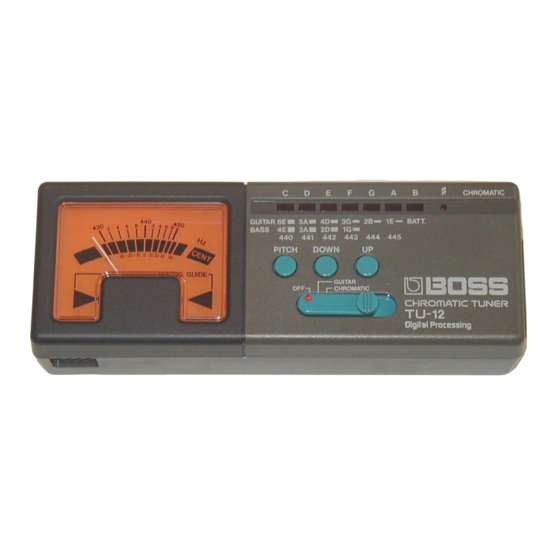
Advertisement
Quick Links
SPECIFICATIONS
Power Consumption
................
Max. 20mMA
Tuning Range .........c0ccccceeeeeeees
C, (32. 70Hz) to Bs (987. 77Hz)
ACCULACY oo... ccee ec ceecececeeeceeneeueeee
+ 1 cent
Master Oscillator ....0..
ee.
Quartz (3. 579545MHz)
Standard Pitch
2.0.0.0...
440 to 445Hz 1Hz step
EIS,
syhgute cupeiae oar
tase tance eeeees
Input, Output, AC Adaptor
DIMENSIONS
.o.cececcceccccccceeeccecees
145(W) x 35(H) x 53(D) mm/
5-7/16 x 1-3/8 x 2-1/16 in
WRIGIVE ra csthinuc Or eticre ice aie acess
170 g/6 oz
* Specifications are subject to change without notice.
UBOSS
Products of Roland
'89-4-A4-11Y
Battery Replacement (9V x 1)
If the indicator under B Starts flashing during operation, proper tuning function is no longer
available. Please replace the battery with a new one.
How to replace the battery
1 Remove
the lid of the Battery
Housing.
2 Take
out
the
battery
and
separate
it
from the Battery Connector.
3 Place
a new
battery.
(Be sure that the
polarity is correct.)
4
Close the lid securely.
Important
@ !f the TU-12 is not to be used for a long time, remove the battery to prevent the trouble
caused by battery leakage.
AC Adaptor
For AC operation, be sure to use the BOSS AC Adaptor PSA-120, 220 or 240 depending on
the voltage system: in your country, and never use one Adaptor for two units simultaneous-
ly
Note
elf the B indicator starts flashing while the
TU-12
is being
operated
with
the
AC
Adaptor,
tuning
is not
possible.
{tf this
happens, turn the TU-12 off, then turn it
on again.
e@ When an amplifier is connected to the TU-
12, set the POWER
switch
of the TU-12
to OFF
immediately
after tuning is com-
pleted
to avoid unnecessory
consumption
of the
battery.
Moreover,
increasing
the
volume
of the amplifier with
the TU-12
on may cause noise.
@ IN: 120, 220, 240V
@ OUT: 9V 200mA
O
@®
UBOSS
MANUAL
CHROMATIC TUNER
TU-12
Digital Processing
RADIO
AND
TELEVISION
INTERFERENCE
"Warning
— This equipment
has been verified to comply
with the limits for a Class B computing device,
pursuant
to Subpart
J, of Part
15, of FCC
rules.
Operation
with
non-certified
or
non-verified
equip-
ment
is likely to result in interference to radio and TV reception."
The
equipment
described
in this
manual
generates
and
uses
radio-frequency
energy.
If it is not
installed
and
used
properly,
that
is, in strict
accordance
with
our
instructions,
it may
cause
interfer-
ence with radio and television
reception.
This
equipment
has
been
tested
and
found
to
comply
with
the
limits
for
a Class
B computing
device
in accordance
with
the specifications
in Subpart
J, of Part
15, of FCC
Rules.
These
rules
are
designed
to provide reasonable
protection
against such a interference
in a residential!
installation.
However,
there
is no
guarantee
that
the
interference
will
not
occur
in a particular
instaliation.
If this
equipment
does
cause
interference
to
radio
or
television
reception,
which
can
be
determined
by
turning
the
equipment
on
and
off,
the
user
is encouraged
to try to correct
the
interference
by the
following measure:
@
Disconnect
other
devices
and
their
input/output
cables
one
at a time.
If the
interference scops,
it
is caused
by either the other
device or its |/O cable.
:
These
devices
usually
require
Roland
designated
shielded
!/O cables.
For
Roland
devices, you can
obtain
the proper
shielded
cable
from
your dealer.
For non
Roland
devices, contact the manufacturer
or dealer for assistance.
If your
equipment
does
cause
interference
to radio
or television
reception,
you
can try to correct
the interference by using one or more of the following measures:
Turn
the TV
or radio antenna
until the interference stops.
Move
the equipment
to one side or the other of the TV
or radio.
Move
the equipment
farther
away
from
the TV
or radio.
Plug the equipment
into an outlet that is on a different circuit than the TV
or radio.
(That
is, make
certain
the
equipment
and
the
radio
or television
set are on circuits controlled
by different circuit
breakers or fuses.)
@®
Consider
installing
a rooftop
television
antenna
with
coaxial
cable
lead-in
between
the antenna
and
TV.
\f necessary,
you
should
consult
your
dealer
or
an
experienced
radio/television
technician
for
additional
suggestions.
You
may
find
helpful
the following
booklet
prepared
by the Federal
Com-
munications Commission:
"'How to Identify and Resolve
Radio-TV
Interference Problems"
This
booklet
is available
from
the
U.S.
Government
Printing
Office,
Washington,
D.C.,
20402,
Stock
No. 004-000-00345.4.
Bescheinigung des Herstellers /Importeurs
Storing the TU-12 in the
Carrying Case BCB-6.
Hiermit wird bescheinigt, da® der/die/das
CHROMATIC
TUNER
TU-12
({Gerat, Typ. Bezeichnung)
in Ubereinstimmung mit den Bestimmungen der
Amtsbl.
Vfg
1046 / 1984
(Amtsblattverfiigung)
funk-entstort ist.
Der
Deutschen
Bundespost
wurde
das Inverkehrbringen
dieses
Gerates
angezeigt und die Berechtigung zur Uberpriifung der Serie auf Einhaltung
der Bestimmungen eingeraumt.
Roland
Corporation
Osaka
/ Japan
Name des Herstellers/Importeurs
For Canada
CLASS
B
NOTICE
CLASSE
B
AVIS:
This digital apparatus
does
not exceed
the Class
B
Cet appareil numérique
ne depasse pas les limites de
limits for radio noise emissions
set out in the Radio
la classe
B au niveau
des émissions
de bruits radio-
Interference
Regulations of the Canadian Department
électriques fixés dans le Réglement des signaux para-
of Communications.
sites par le ministere canadien des Communications.
INSTRUCTION
Advertisement

















Need help?
Do you have a question about the TU-12 and is the answer not in the manual?
Questions and answers